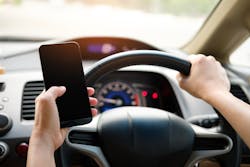Safety Spotlight: The Dangers of Distracted Driving
Each time drivers get behind the wheel of the car and insert the keys into the vehicle’s ignition, they take responsibility for the choices — good or bad — they’re about to make while on the road.
Driving is a complicated activity that affects us physically, mentally, and even emotionally. If distracted, driving is also an activity that can become deadly in a matter of seconds.
The National Highway Traffic Safety Administration (NHTSA) defines distracted driving as “any activity that diverts attention from driving, including talking or texting on your phone, eating and drinking, talking to people in your vehicle, fiddling with the stereo, entertainment or navigation system — anything that takes your attention away from the task of safe driving.”
There are four basic types of distracted driving:
1. Cognitive: distractions to thought and concentration
2. Auditory: distractions affecting your hearing
3. Visual: distractions affecting your ability to see
4. Manual: distractions affecting the ability to use your hands
According to the NHTSA, sending/reading a text message takes your eyes off the road for five seconds. If a vehicle is traveling at 55 mph, that's essentially driving the length of a football field blindfolded.
Talking on a cell phone – even hands-free – or texting or programming an in-vehicle infotainment system diverts your attention away from driving.
Research shows that our brains remain distracted for nearly 27 seconds after engaging in a call or text. Red lights and stop signs aren’t the time to use a device.
The National Safety Council notes, on any given day, more than 700 people are injured in distracted driving crashes.
Ditch your Devices While Driving
As of 2020, 20 states have hand-held cell phone bans and 48 states have banned texting while driving. As many of us are focused on the task of driving full-time, it will become easy to notice how many other drivers are distracted and creating hazards for others.
There are over 330 million wireless connections, and the NHTSA estimates that 9% of drivers at any given time are connected on their cell phones.
I encourage everyone to use your phone’s “Do Not Disturb” function and resist answering texts or emails — whatever it is, it can wait. Most phones are now equipped with automatic replies while driving — give them a shot. Set up navigation routes before beginning your trips and then let your devices be.
Another best practice is switching your cellphone to airplane mode, if needed, to eliminate distractions and the urge to answer texts, calls, or email alerts.
Stay Safe and Focused
The NHTSA offers the following tips for staying safe when driving.
- ·Need to send a text? Pullover and park your car in a safe location. Only then is it safe to send or read a text.
- Designate your passenger as your “designated texter.” Allow them access to your phone to respond to calls or messages.
- Do not scroll through apps, including social media, while driving. Cell phone use can be habit-forming. Struggling to not text and drive? Put the cell phone in the trunk, glove box, or back seat of the vehicle until you arrive at your destination.
When traveling as a passenger, urge any driver who is using their cellphone to put it down.
In addition to device-related safety, as a vehicle operator, be sure to give yourself additional buffer space — beyond the standard three-second following rule — when you encounter distracted drivers.
Signs of a driver is distracted are:
- Inconsistent or widely varying speeds
- Swerving between lanes or off the road
- Tailgating or quick stops
- Visibly using a cell phone
Focusing fully on the task of driving also allows you to plan and adjust early for rapidly changing road conditions and traffic patterns.
An important aspect of defensive driving is to stay alert and concentrate on your driving, as well as your surroundings. If you are not alert and fail to concentrate, your response time to an unsafe situation will decrease, and you may not be able to react promptly to avoid a collision.
Remember, multitasking is a myth. You should never drive and use your phone or engage in any other distraction at the same time.
While April is Distracted Driving Awareness Month, we should all be cautious every month of the year when behind the wheel. Resist the urge — put the cell phone down while driving.
About the Author
Jeremiah Danielson
Jeremiah Danielson is the safety manager for ACRT Pacific. His experience in safety management includes work with the U.S. government, municipalities, and large corporations. Jeremiah served in the United States Navy for seven years and holds a Bachelor of Science in Occupational Safety and Health Technology from the University of Akron and a Master of Science in Environmental Policy & Management from American Military University.
